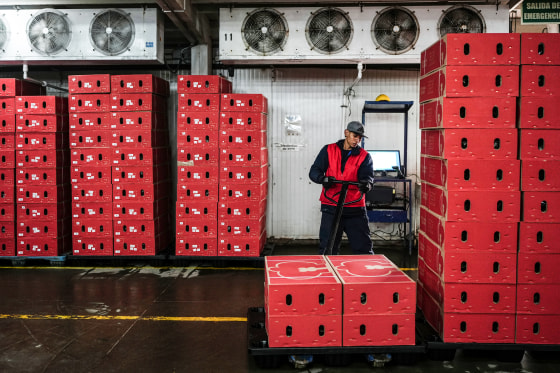
WASHINGTON Right now, tariffs are making headlines. What they are and what you should know about them are as follows:
Tariffs are a tax on imports
Usually, tariffs are assessed as a percentage of the purchase price that a buyer makes from a foreign vendor. At 328 ports of entry throughout the United States, Customs and Border Protection officers collect duties.
Tariff rates in the United States vary; for example, they are typically 2.5% on passenger automobiles and 6% on golf shoes. For nations with which the US has trade agreements, tariffs may be reduced. For instance, Trump’s US-Mexico-Canada trade pact allows the majority of commodities to travel freely between the US, Mexico, and Canada.
Tariffs are typically viewed by mainstream economists as an ineffective means of government revenue raising and prosperity promotion.
There s much misinformation about who actually pays tariffs
President Donald Trump, who supports tariffs, maintains that other nations must foot the bill. In actuality, American corporations that import goods pay tariffs, and the U.S. Treasury receives the money. These businesses then usually raise prices for their clients in order to cover their increased expenses. Economists claim that because of this, consumers typically bear the cost of tariffs.
However, by raising the cost of their goods and making them more difficult to export elsewhere, tariffs can harm other nations. In an effort to counteract the tariffs and preserve their market share in the US, foreign businesses may need to reduce their prices and forfeit earnings. In a study, Yang Zhou, an economist at Fudan University in Shanghai, came to the conclusion that Trump’s tariffs on Chinese goods hurt the Chinese economy more than three times as much as they hurt the American economy.
What has Trump said about tariffs?
Trump has claimed that tariffs will reduce food prices, increase factory jobs, reduce the federal deficit, and enable government childcare subsidies.
During his presidential campaign, Trump declared during a rally in Flint, Michigan, that tariffs are the best invention ever.
Trump aggressively placed taxes on imported solar panels, steel, aluminum, and almost everything else from China while he was president.
He nicknamed himself Tariff Man.
In his second term, Trump has pledged even more and heavier tariffs.
The United States’ post-World War II role of advancing free trade and reducing tariffs around the world has been progressively abandoned in recent years. This change has been a reaction to the decline in manufacturing jobs in the United States, which is generally ascribed to the free trade in trees and China’s growing influence.
Tariffs are intended mainly to protect domestic industries
Tariffs can shield domestic producers by driving up the cost of imports. Additionally, they could be used to penalize foreign nations that engage in unfair trade practices, such as dumping goods at unreasonably cheap costs or subsidizing their exporters.
Prior to the creation of the federal income tax in 1913, tariffs were a significant source of government revenue. Economist Douglas Irwin of Dartmouth College, who has researched the history of trade policy, says tariffs generated 90% of federal revenue between 1790 and 1860.
After World War II, as international trade increased, tariffs lost favor. To fund its operations, the government need much larger sources of income.
Tariffs and taxes brought in around $80 billion for the government in the fiscal year that concluded on September 30. That is insignificant in comparison to the $1.7 trillion from Social Security and Medicare taxes and the $2.5 trillion from individual income taxes.
Nevertheless, Trump intends to implement a budgetary policy that is similar to that of the 19th century.
Additionally, tariffs can be used to exert pressure on other nations on matters that may or may not be connected to trade. For instance, Trump pushed Mexico to crack down on waves of Central American migrants traveling to the United States through Mexico in 2019 by threatening tariffs.
Trump even sees tariffs as a way to prevent wars.
He claimed, “I can do it with a phone call,” during a rally in North Carolina in August.
He indicated he would send a threat if another nation attempted to launch a war:
You will be charged 100% tariffs. And suddenly, the dictator, president, prime minister, or whatever the heck is in charge of the nation tells me, “Sir, we won’t go to war.”
Economists generally consider tariffs self-defeating
For businesses and individuals who depend on imports, tariffs increase expenses. Additionally, they are likely to incite reprisals.
For instance, the European Union retaliated against Trump’s steel and aluminum tariffs by imposing taxes on American goods, ranging from Harley-Davidson motorbikes to bourbon. Similarly, in an effort to harm Trump’s supporters in the agricultural region, China retaliated to his trade war by imposing tariffs on American exports, such as pork and soybeans.
According to a study conducted by economists from the World Bank, Harvard, the University of Zurich, and the Massachusetts Institute of Technology, Trump’s tariffs did not succeed in bringing employment back to the American heartland. According to the report, when the tariffs were intended to protect jobs, they had no effect on U.S. employment.
For instance, the number of jobs at U.S. steel facilities hardly changed—they stayed at about 140,000—despite Trump’s 2018 taxes on imported steel. In contrast, Walmart alone has 1.6 million employees in the US.
Even worse, the study discovered that retaliatory levies levied by China and other countries on American commodities had a detrimental effect on employment, particularly for farmers. The billions of dollars in government assistance that Trump gave to farmers only partially offset these retaliatory tariffs. Businesses that depended on certain imports were also harmed by the Trump tariffs.
Even though Trump’s trade war failed as a policy, it was a political success. The industrial Midwest and manufacturing-heavy Southern states like North Carolina and Tennessee, which were most affected by the import tariffs, saw increases in support for Trump and Republican congressional candidates, according to the report.
